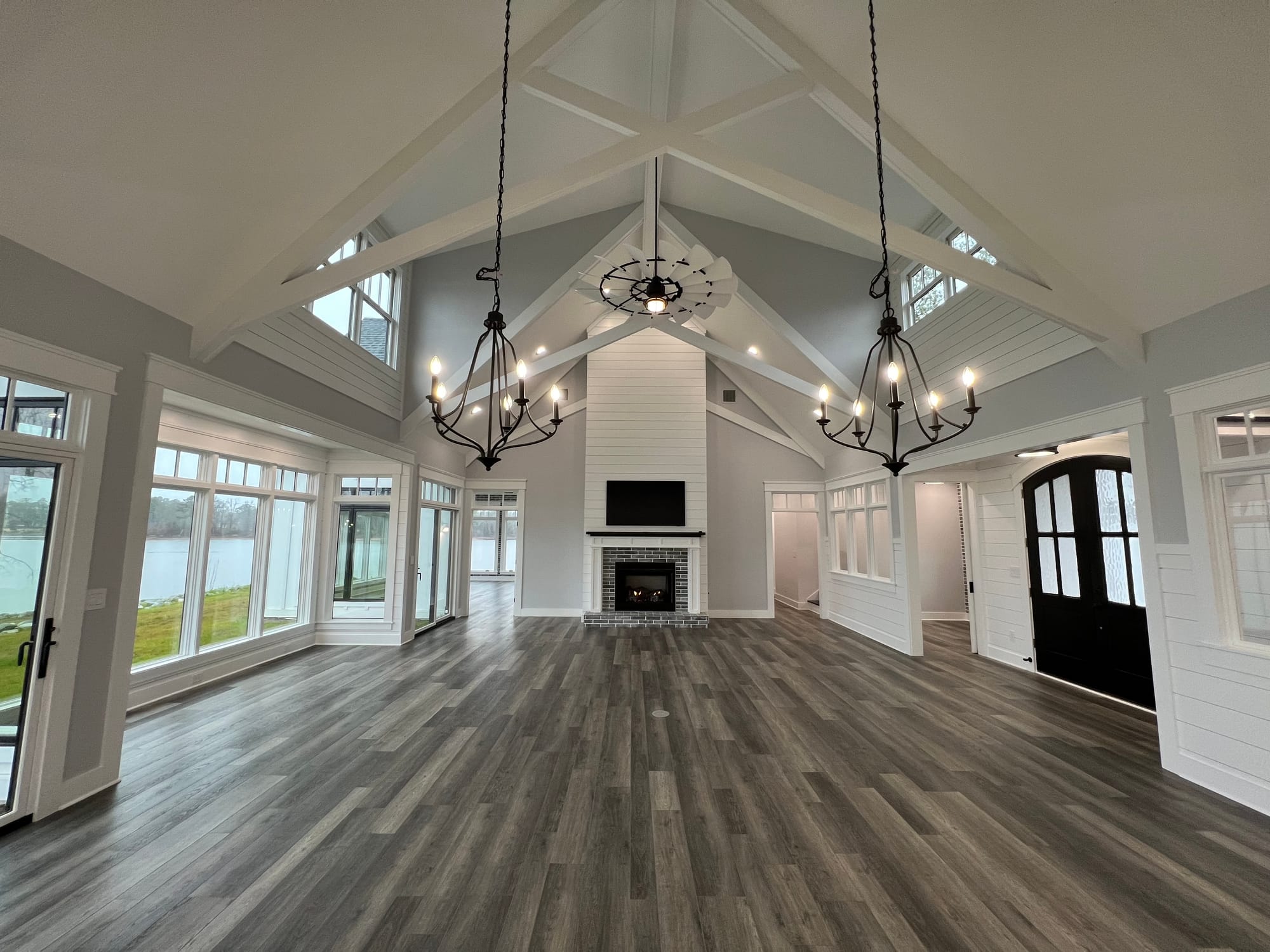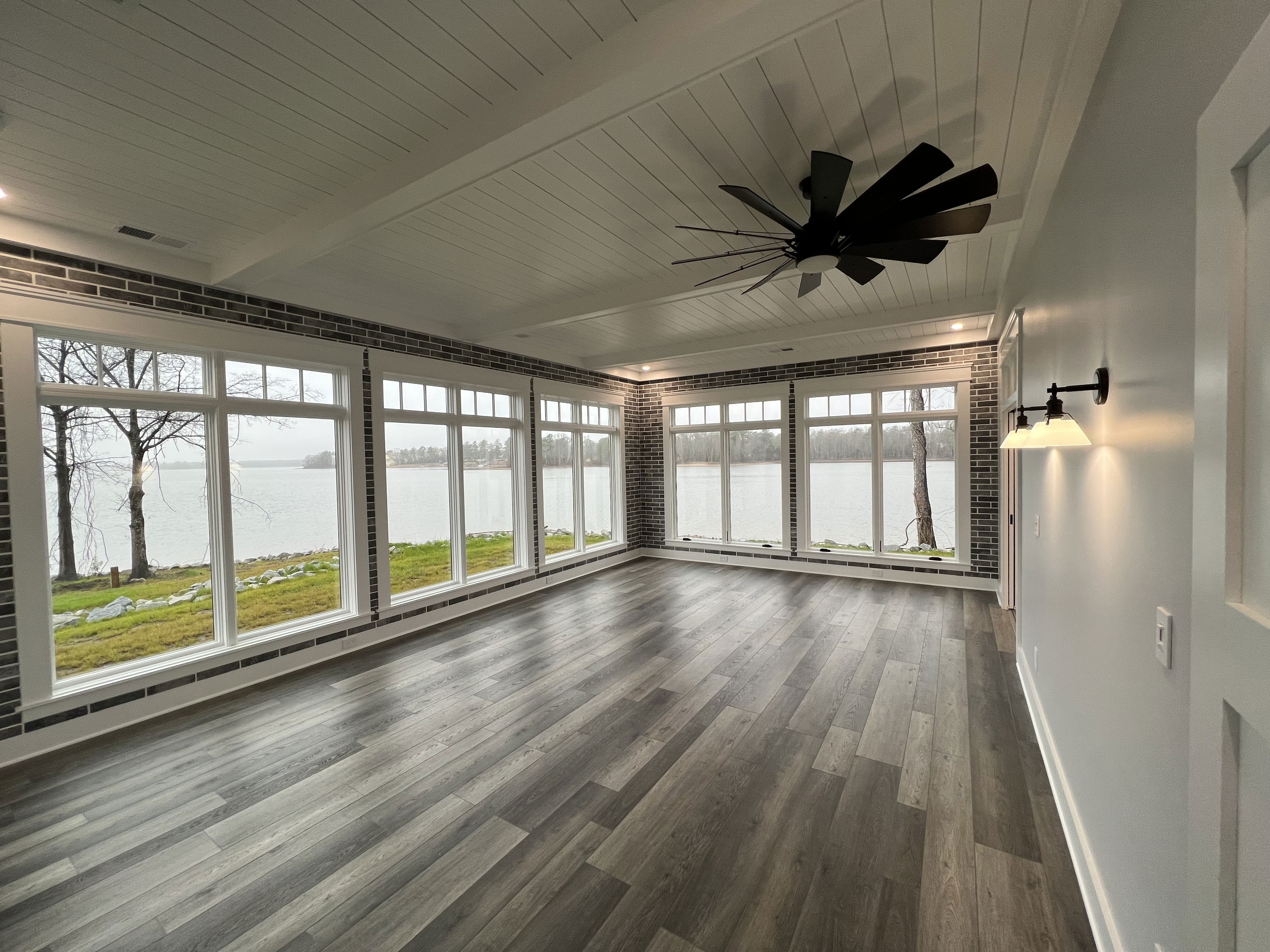Luxury Vinyl Plank (LVP) Flooring


Thinking about LVP flooring for your home?
The following is some general information about vinyl flooring..., some fact, some opinion, and some plagiarized, but it is all based on several years of experience building and renovating beach, intracostal, and lake homes.
We are focusing specifically on floating, click-lock, wood-look plank for this discussion, although much of this holds true for other products such as glue down or Luxury Vinyl Tile (LVT).
Purists like to say that wood is the flooring for high-end homes. Frankly, we love wood… we really do, but it has some issues, and in the right circumstances, those issues (in our opinion) create too much risk and heartache. For example, I would never recommend installing real wood on a concrete slab… not under any circumstance or fancy preparation. I also do not recommend hardwood with pets. But where we really came to appreciate the benefit of vinyl is in homes close to the water. Floors in these homes also have the added risks of sand, mud, wet towels and dripping kids and dogs.
Now even quality vinyl plank floors are not indestructible. They can scratch under certain scenarios (especially from sharp items such as grit/sand and furniture with no foot protection), but they are far more forgiving than hardwood. Our experience is that most scratches are the result of someone dragging something across the floor, with some sharp grit trapped underneath the heavier item (please lift and move items on a floor versus dragging). We find that many of these scratches are in the very top layer and can be ‘burnished’ out with a little patience. We have not encountered pet scratches to LVP flooring, but it is surely possible. Also, it is important to note that serious damage can be trickier to deal with an interlocking plank floor. If for instance someone drops an iron on an LVP floor and the point hits first, putting a dent in said floor, there are only so many options. If the damage is near where they ended laying the floor, you can disassemble some of the planks and replace one. If it is near the beginning/middle of the floor, then you may have to settle with filling the dent, or splicing in a patch of vinyl, which is not for the faint of heart. Or, if using a rustic looking floor, you may choose to live with a dent. With hardwood, there can be better repair options, although some require full floor refinishing which is also not trivial.
Finally, there are a couple of other features we like about LVP. First, we love that it can be installed over existing ceramic tile (under the right circumstances). It can even bridge across large grout joints. Second, and this one may be controversial, but floors go in and out of style. Even classic hardwood lovers argue about the right plank width and whether to stain or leave natural... and don't even get me started about tile size and grout joint widths changing yearly. Well, LVP is a lower priced option and typically floats over the floor. So if in 15 years, you get tired of the look, peeling it up and replacing it is a very viable option.
So let’s talk about the mechanics of the products and what you need to look for….
Each company that produces vinyl flooring have levels of quality and endurance. Shaw, Mohawk, Kraus, Fusion, Southwind, CoreTec, Next Floor, Nuvelle, Happy Feet Int., Karndean, Metro Floor, and the many others out there, all have low and high price points. The quality of the product goes up as the price increases. Flooring is a product that gets better as you pay more most of the time. But like buying wine, the trick is to find the excellent product at a moderate price.
There are 2 big considerations when evaluating vinyl flooring. Durability and Aesthetics.
Luxury vinyl has a few points to look for when checking its durability.
1. Thickness of the material and what it is made of. This is especially important if you are laying it on top of a subloor that is not exactly pristine, or over tile with large grout joints, as these imperfections are more likely to 'telegraph' through thin materials.
2. Thickness of the wear layer on the top. This is the thickness of the print that you see. The product may say 4 mil, 8 mil, 10 mil, 12 mil, 20 mil, or 30 mil wear layer. Each mil is like a sheet of paper thickness. The thicker the wear layer, the more durable the product. We find the sweet-spot is around 12 mil, although for big dogs, you may want to look into 20 mil.
3. Coatings on the material. Newer products have different coatings added to increase scratch resistance. Some products have a diamond coating or a ceramic coating. Some products may not give you a name, but will state that there is a coating of some sort to resist scratching.
4. Core or body of the material will effect cost. The center of the floor (core) is typically made of either solid Wood Polymer (or Plastic) Composite core or WPC. WPC does not contain actual wood. Instead, it is made up of wood flour fused with thermoplastic and calcium carbonates. The other type of core used in Luxury Vinyl Planks (LVP) is Stone Polymer (or Plastic) Composite or SPC core, that is typically comprised of around 60% calcium carbonate (limestone), polyvinyl chloride and plasticizers.Both options are known for being 100% waterproof. SPC is a newer product with a signature rigid core that is virtually indestructible. WPC has been the gold standard for vinyl flooring and features a waterproof core that is comfortable, as well as functional. These tough cores make LVP more rigid, in order to be able to click lock the sides together. We have had better experiences with SPC as it can be denser and result in less 'denting' of the floor when heavy weights are placed or rolled over them. Note that some locks are much easier to work with than others, and some are more prone to problems (such as coming unlocked in the middle of an installation). This can be hard to specify or test, so ask about these issues when looking at flooring.
Luxury vinyl has a handful of points to look for when checking its aesthetics (especially it’s ability to mimic real wood). We are not saying that vinyl flooring will look 100% like real wood, but the better products will surprise you in authentic look.
1. Plank size. LVP and EVP floors come in a variety of plank widths and lengths. Some even come with mixed widths. Choosing the right size really comes down to personal preference. Generally speaking, going with the widest or narrowest is more likely to look dated sooner. A middle of the road width should stay in style a bit longer. Also, we have noticed a tendency for very wide planks (>8”) to cup a little bit.
2. Edge Bevels. We find that boards with bevels (or micro-bevels) on the edges of the boards tend to look best when installed. An all-flat vinyl floor can start to look commercial. Ensure that the edge bevel is color matched to the rest of the board so it does not stand out excessively.
3. Embossing. Boards should be embossed with a realistic wood grain pattern, including knots or other features (if present). Smooth flooring will not look real.
4. Registration. It is not sufficient that the plank be embossed with texture. That texture should also coincide with the pattern on the plank. In other words, if there is an image of a knot on the board, then there should also be the texture of a knot aligned perfectly with the image. Together, texture and print will combine for realism.
5. Pattern repeat. LVP planks are printed with a pattern. It is important to know how many plank variants there are in a product line (Usually between 4 and 13 distinct patterns). The reason being that if there is (for example) a very unique knot in the pattern, and when the floor is laid there are several of that same knot close together, it detracts from the realism. That said, the more plank variants there are in a product the easier it is to stagger the patterns. A good floor installer will open many boxes, figure out his quantities of each pattern, and pay attention to this staggering to create pseudo-randomization. This also an area where choosing a random-width floor style can help minimize the look of repeat patterns.
These are the basic features to look for when shopping for luxury vinyl. If you go to Lowes or Home Depot, you may not find this information on the labeling. You will be better off to find your local flooring stores and they can help you find quality flooring and explain the cost differences of their products. While we believe in supporting local small business, there are many online retailers who will discount heavily, especially when purchasing house-sized quantities. Sometimes you can bring these web quotes back to your local stores to get the price down.
We hope this helps you in your quest for knowledge... and best of luck with your flooring project!